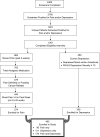The association of depression and pain with health-related quality of life, disability, and health care use in cancer patients
- PMID: 20580201
- PMCID: PMC2934745
- DOI: 10.1016/j.jpainsymman.2009.12.023
The association of depression and pain with health-related quality of life, disability, and health care use in cancer patients
Abstract
Context: Pain and depression are two of the most prevalent and treatable cancer-related symptoms, each present in at least 20%-30% of oncology patients.
Objective: To determine the associations of pain and depression with health-related quality of life (HRQL), disability, and health care use in cancer patients.
Methods: The Indiana Cancer Pain and Depression study is a randomized clinical trial comparing telecare management vs. usual care for patients with cancer-related pain and/or clinically significant depression. In this article, baseline data on patients enrolled from 16 urban or rural community-based oncology practices are analyzed to test the associations of pain and depression with HRQL, disability, and health care use.
Results: Of the 405 participants, 32% had depression only, 24% pain only, and 44% both depression and pain. The average Hopkins Symptom Checklist 20-item depression score in the 309 depressed participants was 1.64 (on 0-4 scale), and the average Brief Pain Inventory (BPI) severity score in the 274 participants with pain was 5.2 (on 0-10 scale), representing at least moderate levels of symptom severity. Symptom-specific disability was high, with participants reporting an average of 16.8 of the past 28 days (i.e., 60% of their days in the past four weeks) in which they were either confined to bed (5.6 days) or had to reduce their usual activities by 50% (11.2 days) because of pain or depression. Moreover, 176 (43%) participants reported being unable to work because of health-related reasons. Depression and pain had both individual and additive adverse associations with quality of life. Most patients were currently not receiving care from a mental health or pain specialist.
Conclusion: Depression and pain are prevalent and disabling across a wide range of types and phases of cancer, commonly co-occur, and have additive adverse effects. Enhanced detection and management of this disabling symptom dyad is warranted.
Published by Elsevier Inc.
Figures
References
-
- Bottomley A. Depression in cancer patients: a literature review. Eur J Cancer Care. 1998;7:181–191. - PubMed
-
- Caraceni A, Portenoy RK. An international survey of cancer pain characteristics and syndromes. IASP Task Force on Cancer Pain. International Association for the Study of Pain. Pain. 1999;82:263–274. - PubMed
-
- Portenoy RK, Lesage P. Management of cancer pain. Lancet. 1999;353:1695–1700. - PubMed
-
- Given CW, Given B, Azzouz F, Kozachik S, Stommel M. Predictors of pain and fatigue in the year following diagnosis among elderly cancer patients. J Pain Symptom Manage. 2001;21:456–466. - PubMed
Publication types
MeSH terms
Substances
Grants and funding
LinkOut - more resources
Full Text Sources
Medical
Miscellaneous


